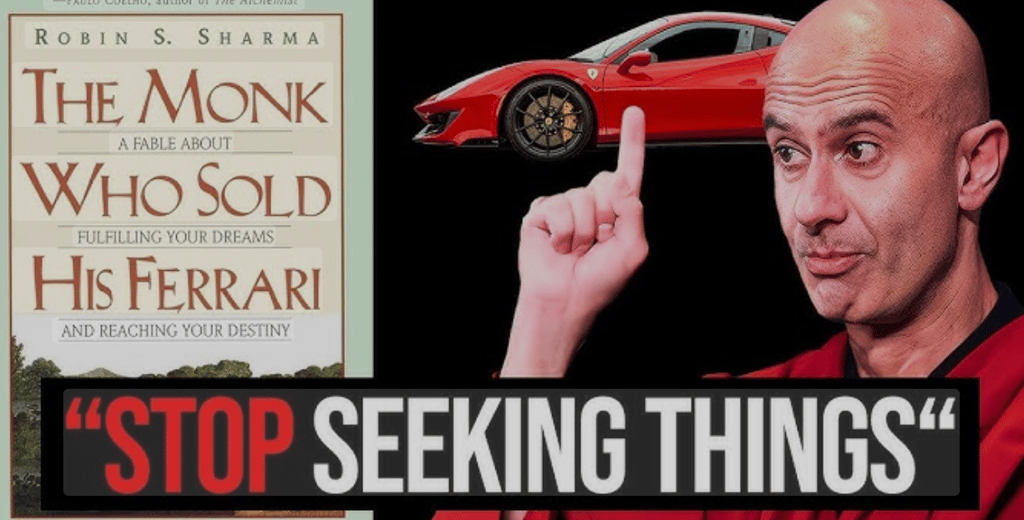“The Monk Who Sold His Ferrari,” Stripped Down: Parable, Practice, and the Fine Print
Verdict: Read for entry-level mindset shifts and ritual prompts. Skip if you need rigorous psychology or a realistic blueprint for systemic change.
BOOKS
9/21/20255 min read


The Big Idea
This is a fable about a high-flying lawyer who burns out, retreats to the Himalayas, and returns with a set of simple principles for a meaningful life. The pitch: master your mind, clarify your purpose, practice small improvements, enforce discipline, respect time, serve others, and savor the present. The book solves the “I’m successful but empty” problem at the level of daily habits and mindset. It does not solve structural issues (toxic workplaces, economic precarity), and it doesn’t try to.
What’s New Here (and Why It Matters)
Nothing here is academically new. What’s useful is the mnemonic parable—a string of vivid symbols that compress a life philosophy into something you can remember on a Monday morning. Compared with similar parables (Not provided), Sharma puts more weight on rituals (early rising, solitude, focused work, journaling, service) as the engine of change. Readers won’t learn cutting-edge behavioral science; they will get low-friction routines that require almost no tools.
Core Arguments / Plot Architecture (spoiler-safe)
Structure: A mentor–mentee conversation frames a parable featuring seven symbolic elements. Each symbol maps to a virtue and a handful of practical rituals. The story is intentionally simple; the takeaways are what matter.
Key claims (nonfiction):
Master your mind (the garden): guard attention, prune negative thoughts.
Follow your purpose (the lighthouse): define a clear, values-aligned target.
Practice Kaizen (the sumo): improve in small, steady steps.
Discipline (the pink wire coil): build self-control with small promises kept.
Respect your time (the gold stopwatch): schedule what matters, cut trivia.
Selfless service (fragrant roses): contribution creates meaning.
Embrace the present (diamond-studded path): savor now; don’t defer life.
Evidence style: Anecdotes and parable logic. Minimal citations. The book relies on plausibility and resonance, not data.
Deep Dive
Frameworks & Models
The Garden (Mind Management):
Use: Keep a distraction ledger for three days. Note what hijacks attention. Remove one repeating trigger (mute a thread, delete one app). Plant one “seed” daily: a 30-minute reading or thinking block.
The Lighthouse (Purpose):
Use: Write a one-sentence aim for the next 90 days. Attach two measurable weekly actions. If an item doesn’t serve the lighthouse, it’s optional by default.
The Sumo (Kaizen):
Use: Pick one skill. Define a daily 15-minute drill. Track streaks. Increase difficulty by 10% after 7 successes.
The Pink Wire (Discipline):
Use: Choose one non-negotiable (e.g., 10K steps, 20 pages, lights-out at 11). Put it on your calendar. If you miss, do a micro-make-good within 24 hours.
The Stopwatch (Time Mastery):
Use: Time-block the day. Cap shallow work at ≤30%. Protect one 60–90 minute deep block before lunch. Meetings require agenda + decision owner or they don’t happen.
The Roses (Service):
Use: Daily one-act service: useful message, intro, errand, mentoring call. Log it. Service keeps ambition from curdling into vanity.
The Diamonds (Presence):
Use: Install two device-free zones: first 30 minutes after waking and meals. Take one 10-minute slow walk without audio.
These are pragmatic interpretations of the book’s themes, not verbatim frameworks.
Evidence Check
Where it lands: The rituals echo known behavior-change basics—cue control, time blocking, habit streaks, values alignment. Low risk, easy to trial.
Where it’s thin: No serious engagement with trade-offs, personality differences, or counterevidence. The cause-and-effect from ritual → enlightenment is asserted, not tested. Cultural tropes (mystical wisdom in the mountains) simplify a complex tradition.
Assumptions Under the Hood
You can restructure some of your day.
Your workplace won’t punish less availability if outcomes are solid.
Meaning is accessible through routine more than radical change.
If any of these fail, expect frictions the book doesn’t model.
Practical Takeaways
One-line 90-day aim + two weekly actions on your calendar.
60–90 minute deep block each morning, phones out of sight.
15-minute Kaizen drill on a single skill; track streaks.
Non-negotiable ritual: bedtime, reading pages, or daily walk—pick one.
Service habit: one useful action for someone else before noon.
Device-free edges: morning ramp and meal times.
Monthly reset: review time blocks; cancel one shallow recurring commitment.
Mini-Checklist (print this)
Write your lighthouse sentence.
Block tomorrow’s deep hour.
Choose one non-negotiable.
Log one service act today.
Set two device-free zones.
Contrarian Note
The book suggests that personal ritual reliably produces life transformation. Sometimes it does. Often, context beats willpower: caregiver schedules, shift work, or hostile incentives will erase your deep hour. Rituals help—if you also renegotiate workload, boundaries, and expectations. Otherwise you create a perfect routine for the wrong job.
Blind Spots & Risks
Cultural flattening: Himalayan sages are used as a universal mirror; nuance is lost.
Evidence-light: Claims lean on inspiration; there’s little about failure modes.
Privilege & precarity: The advice presumes discretionary time and safety nets.
Hustle repaint: “Discipline” can become guilt if you don’t also remove structural friction.
Commercial halo: Readers may confuse story resonance with guaranteed outcomes.
Who Should Read This (and Who Shouldn’t)
Read if:
You want a gentle on-ramp to purpose and habit building.
You like parables and want rememberable symbols to anchor routines.
You’re rebooting after burnout and need simple, humane guardrails.
Skip if:
You need data, citations, or clinical guidance.
You prefer systems engineering over parables.
Your main blockers are organizational; this book won’t fix your boss.
How to Read It
Pacing: Weekend read; then spend two weeks installing one ritual at a time.
Skim vs. slow down: Skim the fable once; slow down on the practice sections and your calendar.
Format: Audio works for tone; print/ebook is better for marking up your lighthouse, rituals, and time blocks.
Companion move: Pair with a pragmatic planner or habit tracker; keep it boring and consistent.
Scorecard (1–10)
Originality: 6 — Familiar wisdom, memorable packaging.
Rigor / Craft: 4 — Clean storytelling, evidence-light.
Clarity: 8 — Symbols are sticky; steps are plain.
Usefulness: 7 — High if you actually schedule and simplify.
Re-read Value: 6 — Good as a seasonal reset.
If You Liked This, Try…
The Alchemist (Paulo Coelho): Another parable about purpose; lighter on tactics.
Essentialism (Greg McKeown): Concrete methods for saying no and focusing.
Atomic Habits (James Clear): Habit mechanics to operationalize Sharma’s rituals.
Man’s Search for Meaning (Viktor Frankl): Deeper existential grounding beyond motivation.
Stillness Is the Key (Ryan Holiday): Modern stoic take on clarity and calm.
FAQ
Is it a true story or fiction?
It’s a parable—story first, instruction second. Treat the symbols as tools, not reportage.
Do I need to wake up at 5 a.m. to benefit?
No. Early rising is optional. What matters is a protected block for meaningful work.
Can I apply this without quitting my job?
Yes—start with time blocking, one non-negotiable ritual, and a service habit. If your context fights you, renegotiate expectations.
Is it religious?
It borrows spiritual language but functions as secular self-help. No doctrine required to use the practices.
Final Verdict
Treat this book like a starter kit: a memorable parable that points you to seven everyday levers—attention, purpose, Kaizen, discipline, time, service, presence. If you’re early in the journey or coming back from burnout, buy it and implement one ritual per week. If you want rigorous evidence or workplace reform, borrow it for the symbols and pair it with hard-nosed operations and boundary-setting. The wisdom is simple; the hard part is calendar reality.




